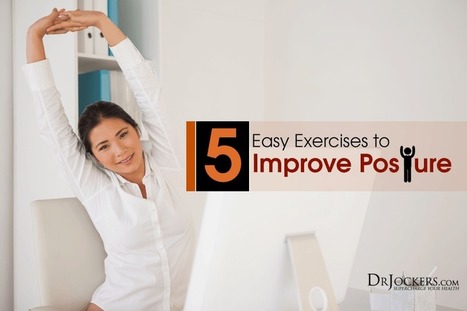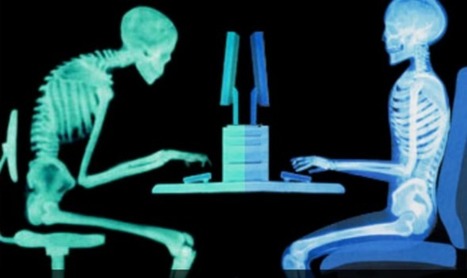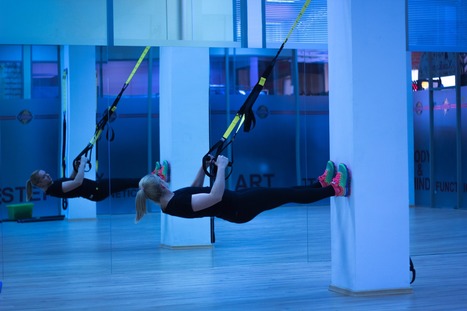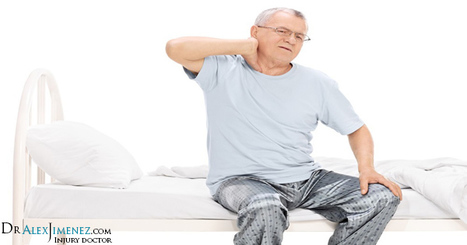 Your new post is loading...
 Your new post is loading...
Question: I work at a desk all day and have started to feel pain in my neck, back, shoulders and arms. Can chiropractors help with sitting posture and general posture? El Paso, TX. Chiropractor, Dr. Alexander Jimenez provides insight into proper sitting posture and general posture through chiropractic. Have people asked you about using a posture brace to help correct their sitting habits? Chiropractic patients with moderate posture problems, meaning that they may be chronic but are not tied to any spinal column or other medical condition, may benefit from a posture back brace to improve this condition. There are a number of great ones available, and you can see more information about some of the top ones here. A patient such as this will almost certainly enjoy the quick referral as well as the relatively fast results, and chiropractors get an easy opportunity to help people, which explains why many enter the profession in the first place. But if the patient does have an underlying chiropractic ailment, a back brace will probably do little if any good. These issues are usually easily diagnosed using a quick examination, and afterwards, treatment is relatively straightforward as well. Diagnosing ConditionsAll good exams begin with thorough health history, because in most cases, family history is among the most powerful indicators about current issues. Next, observe the individual's gait, as how someone walks shows a number of issues. For instance, those who stand or walk with their legs abnormally spread might have fallen arches. Because the bottom of the foot isn't in appropriate contact with the floor, the whole body has been thrown off kilter, resulting in poor posture. While it isn't really a chiropractic condition, fallen arches are, as simple as, a referral to an orthopedist. Moreover, if the patient is experiencing pain, the location can be an indicator as to where the muscles may be weak and there is too much strain on the spine or a different region of the body. Muscle weakness is among the leading causes of poor posture. So, follow-up tests that measure muscle strength and range of movement are usually a good idea. If the gait examination signals issues in a particular area of the body, the professional should concentrate further diagnostic efforts in that region. Ultimately, one of the most simple and effective evaluations is just holding a yardstick or comparable object against the patient's back, so the two of you can definitely see any abnormalities. This comprehensive approach generally describes some of the very frequent chiropractic posture issues, including: Tissue Damage:If the neck, lower back, mid back, or any other area is weak and/or inflexible, the individual will probably not see very much posture improvement until these conditions are adjusted and the muscles have been strengthened. Kyphosis:Hunchback is a degenerative spine condition that's very prevalent in women over 60. While more advanced cases may be life threatening and may require spinal fusion surgery, most men and women respond well to therapeutic adjustments and other treatments. Scoliosis:This condition is much like genetically-induced kyphosis, since there's no cure but there are several therapies available. In extreme cases, surgery may be necessary. Un-Level Pelvis/Pelvic Tilt:A pelvic tilt, a lower sacral base, and a femur head discrepancy can indicate a lower extremity source, but not whether it is an anatomical or functional short leg. A clinical postural exam with lower extremity screening is the only way to make this determination. Forward Head Posture:The anterior positioning of the cervical spine. This posture is sometimes called Scholar's Neck, Wearsie Neck, Hunch & or Reading Neck.It is a posture problem that is due to several factors including sleeping with the head raised too high, prolonged use of computers and cellphones, lack of developed back muscle strength and deficiency of nutrients like calcium. Potential negative effects include tingling and numbness in the arms, and a burning pain between the shoulder blades. TreatmentAs stated previously, back braces frequently mend postural issues, like slouching. As for structural problems, like scoliosis, more aggressive treatments are needed. Conventional treatment consists of: - Heat
- Massage
- Stretching
- Strength exercises
- Supportive braces
There are a number of biofeedback tools that accurately evaluate patient progress. As a chiropractor, your patients count on you to get much better. That almost always means accurately assessing the problem, which also means a quick and capable referral or an aggressive and well thought out therapy regimen.
There are more benefits to gardening than blossoming flowers and fresh produce. It's also an opportunity to stay active while enjoying the outdoors. With thousands of people getting treated in emergency rooms for gardening-related injuries, the American Academy of Orthopaedic Surgeons (AAOS) wants to ensure that outdoor gardeners are practicing safety first. Research from the National Electronic Injury Surveillance System (NEISS) shows the following results for individuals treated in hospital emergency rooms in 2015:
Do you yearn for a strong and flexible back along with a super flat tummy? So, what’s the relationship between a strong back and super flat tummy? When your back is strong and flexible, you will be able to work on strengthening and toning your core muscles. And, when your core shrinks and tones, you will enjoy a flat tummy. Bonus – better posture, better digestion, regular bowels, more energy, and a happier you!
El Paso, TX. Chiropractor Dr. Alex Jimenez looks at sleep posture for back pain.
Whether you got back, neck, or pregnancy pain, your slumber posture makes a big difference in the way you feel each morning.
Great posture is a key to a healthier spine, but posture isn’t just about sitting or standing straight. Your sleep bearing has a significant effect on neck and your back. While some postures allow you to feel refreshed morning, come, others can leave you stiff, sore, and in pain.
Believe neutral, as it pertains to locating the very best sleep pose to your back and neck. Postures that put your spine in a neutral, or direct, alignment place the smallest amount of pressure on your own back and neck. Learn which postures set your back in a neutral state and those who must be prevented below.
The Very Best Sleep Posture For The Back: On Your Own Back
Sleeping in your back is for putting your spine in a neutral alignment, the very best, but only 8% of people sleep in this pose.
A few strategically placed pillows can boost the advantages of back sleep. A little pillow underneath your head and neck (but not your shoulders) will help to keep your back straight. Including a pillow under your knees will provide comfort and much more support, as it encourages your back to preserve its natural curve.
It’s a few drawbacks, though back sleeping is the best on your spine:
- It’s not best for individuals with sleep apnea. Back sleeping may create the tongue to obstruct the breathing tube, so those with sleep apnea must not sleep on their backs. Instead, they ought to sleep on their side with legs right.
- It’s not best for snorers. Back sleeping can worsen snoring. People who snore should sleep on their side with legs right.
- It’s not best for women that are pregnant. Pregnant women who sleep on their backs danger growing a multitude of health issues, from back pain to low blood pressure. Plus, the on-the-back position decreases blood flow to the baby and also the heart. The very best sleep position during pregnancy is sleeping on the side with legs bent.
The Next Best Choice: On Your Side With Legs Straight
For those that snore or have sleep apnea—or in the event you just discover sleeping on your back uncomfortable—side sleeping with your torso and legs is a fantastic choice. That is the perfect sleeping pose for people and snorers with sleep apnea because it keeps your airways open. Adding a tiny pillow between your legs will also help in keeping your back neutral.
In Third: On Your Side With Legs Bent Upwards
Sleeping on your side together with your legs bent upwards—also generally known as the fetal position—is the most typical sleep pose (41% of adults sleep this manner). This posture keeps your neck and upper back, though it’s a popular alternative. The fetal position also promotes an uneven distribution of weight, which can cause tender joints and back pain. You can help reduce your odds of waking up by pulling your knees and maintaining your turning angle up as high as they can go.
While this is the third-best slumber pose for most, sleeping on your side with bent legs is the best sleeping position for women that are pregnant. It supplies the most comfort and safety for a growing abdomen, and sleeping on the left side adds the additional benefits of boosting blood and nutrients to the baby. For additional support, pregnant women may put in a pillow between their bent legs and knees.
The One Sleep Position Everyone Should Avoid
No matter the sort of pain you might have, whether it’s neck, low back, joint, or related to pregnancy, sleeping on your stomach just isn’t recommended. This posture places the most pressure on joints and your back’s muscles as it flattens the natural curve of your back. Sleeping on your stomach also compels you to turn your neck, which may cause neck and upper back pain.
Getting the sleep you need is much more important while stomach sleeping is better prevented. You are able to calm some pressure off your back by placing a pillow under your pelvis and lower abdomen, and another pillow under your head if stomach sleeping is the sole way you can snooze soundly. In the event the pillow under your head causes pain, remove.
Still Feeling Sleepy?
You struggling to get a great night’s rest, although when you yourself have sleep bearing that is healthful, factors outside your sleep position may be the offender. As an example, environmental disruptions (for example bright lights in your bedroom) or dietary customs (like eating a substantial meal before bed) could be interfering together with your slumber. Learn about some common sleep burglars and how you can combat them in Sensible Sleep Advice to get a Wholesome Spine.
Text Neck Syndrome & Chiropractic
The Modern Sore Neck
You may have noticed a new buzzword in health news recently: Text neck.
See How to Avoid Neck Pain from Texting
Text neck is the term used to describe the neck pain and damage sustained from looking down at your cell phone, tablet, or other wireless devices too frequently and for too long.
Children & Teens Especially At Risk For Suffering Symptoms Of Text Neck.
Learn more: How to Avoid Text Neck Overuse Syndrome
Recently, a patient came in to my practice complaining of severe upper back pain. He woke up and was experiencing severe, acute, upper back muscle strain. I told him I believe the pain is due to the hours he was spending hunched over his cell phone. Diagnosis: Text neck.
See All About Upper Back Pain
This posture of bending your neck to look down does not occur only when texting. For years, we've all looked down to read. The problem with texting is that it adds one more activity that causes us to look down—and people tend to do it for much longer periods. It is especially concerning because young, growing children could possibly cause permanent damage to their cervical spines that could lead to lifelong neck pain.
See Cervical Spine Anatomy and Neck Pain
Symptoms Associated With Text Neck?
Text neck most commonly causes neck pain and soreness.
In addition, looking down at your cell phone too much each day can lead to: - Upper back pain ranging from a chronic, nagging pain to sharp, severe upper back muscle spasms.
- Shoulder pain and tightness, possibly resulting in painful shoulder muscle spasm.
- If a cervical nerve becomes pinched, pain and possibly neurological symptoms can radiate down your arm and into your hand.
See What Is Cervical Radiculopathy?
As some studies suggest, text neck may possibly lead to chronic problems due to early onset of arthritis in the neck.
See Facet Joint Osteoarthritis
Watch: Neck Strains and Sprains Video
Poor neck posture of all kinds, not just from texting, can lead to strain or sprain.
How Common Is Text Neck?
A recent study shows that 79% of the population between the ages 18 and 44 have their cell phones with them almost all the time—with only 2 hours of their waking day spent without their cell phone on hand.1
See Causes of Upper Back Pain
How Is Text Neck Treated?
First, prevention is key. Here are several pieces of advice for preventing the development or advancement of text neck:
Hold your cell phone at eye level as much as possible. The same holds true for all screens—laptops and tablets should also be positioned so the screen is at eye level and you don't have to bend your head forward or look down to view it.
See Ten Tips for Improving Posture and Ergonomics
Take frequent breaks from your phone and laptop throughout the day. For example, set a timer or alarm that reminds you to get up and walk around every 20 to 30 minutes.
If you work in an office, make sure your screen is set up so that when you look at it you are looking forward, with your head positioned squarely in line with your shoulders and spine.
See Ergonomics of the Office and Workplace: An Overview
The bottom line is to avoid looking down with your head bent forward for extended periods throughout the day. Spend a whole day being mindful of your posture—is your head bent forward when you drive? When you watch TV? Any prolonged period when your head is looking down is a time when you are putting excessive strain on your neck.
See Office Chair, Posture, and Driving Ergonomics
Watch: Neck Strains and Sprains Video
Keeping the neck straight and your phone at eye level can help prevent text neck.
Rehabilitation Is Important
Many people don't know this, but you need to have strong core muscles—the abdominal and lower back muscles—to support your upper body, including your neck. Your core muscles usually do not get enough exercise during normal daily activities, so you need to do specific exercises to target these muscles.
See Core Body Strength Exercises
You also need strong and flexible muscles the neck to minimize strain on your cervical spine and help support the weight of your head. Again, your neck will not get sufficient stretching and strengthening during normal daily activities, so it is best to learn specific neck exercises with the help of a health professional.
See Neck Stretches
Some people will also benefit from a more comprehensive treatment plan, such as a combination of manual adjustments, massage therapy, and cold laser therapy.
Chiropractic Leads the Charge Against “Text Neck Syndrome”
( Los Angeles Times) Dr. Dean Fishman, a chiropractor in Florida, was examining an X-ray of a 17-year-old patient’s neck in 2009 when he noticed something unusual. The ghostly image of her vertebral column showed a reversal of the curvature that normally appears in the cervical spine — a degenerative state he’d most often seen in middle-aged people who had spent several decades of their life in poor posture.
“That’s when I looked over at the patient,” Fishman says. She was slumped in her chair, head tilted downward, madly typing away on her cellphone. When he mentioned to the patient’s mother that the girl’s posture could be causing her headaches, he got what he describes as an “emotional response.” It seemed the teen spent much of her life in that position. Right then, Fishman says, “I knew I was on to something.”
The flexed neck can put strain on cervical disks. (Zephyr / Getty Images/Brand X)
He theorized that prolonged periods of tilting her head downward to peer into her mobile device had created excessive strain on the cervical spine, causing a repetitive stress injury that ultimately led to spinal degeneration. He began looking through all the recent X-rays he had of young people — many of whom had come in for neck pain or headaches — and he saw the same thing: signs of premature degeneration.
Fishman coined the term “text neck” to describe the condition and founded the Text Neck Institute (text-neck.com), a place where people can go for information, prevention and treatment.
“The head in neutral has a normal weight” of 10 to 12 pounds, says Fishman, explaining that neutral position is ears over shoulders with shoulder blades pulled back. “If you start to tilt your head forward, with gravity and the distance from neutral, the weight starts to increase.”
A recent study in the journal Surgical Technology International quantified the problem: As the head tilts forward 15 degrees from neutral, the forces on the cervical spine and supporting musculature increase to 27 pounds. As the tilt increases, the forces increase to 40 pounds at 30 degrees, 49 pounds at 45 degrees and 60 pounds at 60 degrees.
“When your head tilts forward, you’re loading the front of the disks,” says Dr. Kenneth Hansraj, study author and chief of spine surgery at New York Spine Surgery & Rehabilitation Medicine. Though the study didn’t look at long-term effects of this position, Hansraj says that, after seeing approximately 30,000 spinal surgery patients, he’s witnessed “the way the neck falls apart.”
He explains, “When you’re eccentrically loading the spine, you’re going to get cracks in the disks, slipped disks or herniated disks. This leads to stenosis or blockage of the spine.”
In addition, Fishman says, text-neck posture can lead to pinched nerves, arthritis, bone spurs and muscular deformations. “The head and shoulder blades act like a seesaw. When the head goes forward, the shoulder blades will flare out … and the muscles start to change over time.”
Much like tennis elbow doesn’t occur only in people who play tennis, text neck isn’t exclusive to people who compulsively send text messages. Hansraj says people in high-risk careers include dentists, architects and welders, whose heavy helmets make them especially vulnerable. He adds that many daily activities involve tilting the head down, but they differ from mobile-device use in intensity and propensity.
I’ve noticed a LOT of adolescents slumped over their phone sitting in the passenger seat of their parent’s cars….there will be a whole range of physical and emotional problems that result from this behavior, believe these printed words! See you in the future!
“Washing dishes is something nobody enjoys, so you do it quickly. And while your head is forward, it’s probably tilted at 30 or 40 degrees,” he says. People tend to change position periodically while reading a book, and they glance up frequently while holding an infant. But mobile devices are typically held with the neck flexed forward at 60 degrees or greater, and many users, particularly teens, use them compulsively. The study reports that people spend an average of two to four hours a day with their heads tilted at a sharp angle over their smartphones, amounting to 700 to 1,400 hours a year.
To remedy the problem, Hansraj has a simple message: “Keep your head up.” While texting or scrolling, people should raise their mobile devices closer to their line of sight. The Text Neck Institute has developed the Text Neck Indicator, an interactive app that alerts users when their smartphones are held at an angle that puts them at risk for text neck ($2.99, available for Android; in development for iPhone).
Fishman also recommends that people take frequent breaks while using their mobile devices, as well as do exercises that strengthen muscles behind the neck and between the shoulder blades in order to increase endurance for holding the device properly.
He adds, “I’m an avid technology user — and I use it in the proper posture.”
Exercises To Ease The Strain Of ‘Text Neck’
If you’re not mindful of your body alignment, engaging with mobile devices for long periods of time can wreak havoc on your spine. This behavior can result in muscle strain, a straightening of the normal curvature of the cervical spine, disk compression, slipped disks, pinched nerves and arthritis. Here are some exercises that can help prevent and relieve “text neck”:
Neck Stretches
Increasing the range of motion in the neck keeps the cervical spine flexible and helps maintain its normal curvature. Gentle stretches relieve neck tension as well as lengthen muscles that may have shortened due to chronic poor posture.
First, relax your shoulders and nod your head “yes” and “no” slowly a few times. Then, holding one arm behind your back, grasp the side of your head with your opposite hand and press gently, tilting your head to the side until you feel a gentle stretch. Hold for 20 seconds. Next, tilt your chin up and hold for 20 seconds; tilt your chin down and hold for 20 seconds. Repeat on the other side.
Chest Opener
Expanding the chest muscles helps to counteract slumped posture.
Stand in a doorway with your arms held out from the body like a T, forearms resting on each doorjamb at a 90-degree angle to upper arms. Next, lean your body forward through the doorway, leading with your sternum until you feel a gentle stretch across your chest. Hold for 20 seconds. Now move your arms up the door jamb so they are positioned like a V and repeat the forward stretch, again holding for 20 seconds.
Shoulder, Upper Back & Neck Muscle Strengtheners
Strong muscles in the back of the neck and between the shoulder blades will support proper posture, preventing muscle strain and spinal degeneration. With more strength, you will be able to comfortably hold your mobile device in your line of sight without having to bend your neck forward and hunch over. Here are two exercises that help strengthen these postural support muscles:
Wall Angels
If you’ve ever made snow angels, you can use a similar movement to strengthen your shoulder muscles while standing against a wall. First, stand with your heels, back and head resting against a wall. Hold arms perpendicular to the body with the forearms pointing upward at a 90-degree angle to your upper arms. Press your shoulder blades back and down. Keeping your arms bent at a 90-degree angle, move them slowly overhead without letting them lift from the wall. Next, move arms slowly down until your upper arms touch the sides of your body. (Forearms are still perpendicular to upper arms, and shoulder blades are still locked down.) Do 12 repetitions.
Sky Diver
Lying face-down on a mat or other firm, comfortable surface, hold your arms straight over your head at an angle so your body forms the shape of a Y. Lift your upper torso from the mid-back, leading with your sternum and keeping your chin down so your neck is aligned with your spine. Hold for 30 seconds, then release. Next, still lying face-down, hold your arms straight out to the sides so your body forms the shape of a T. Rotate your arms so your thumbs are pointing skyward. Once again, lift your upper torso from the mid-back, leading with your sternum and keeping your chin down. While maintaining the upper body lift, pinch your shoulder blades together as you slowly lift and lower your arms for 12 repetitions.
5 Easy Exercises to Improve Posture
The natural curve of the spine is reinforced by correct posture. Posture not only influences how you look but helps you breathe, improves concentration, supports vital organ function and stimulates overall well-being.
Ignoring harmful postural habits leads to illness, discomfort and pain, and increases the risk for pathogenesis of disease in the body. You can improve your posture and nervous system function and improve your quality of life significantly.
At the bottom of this article, you will discover a video and narrative for 5 exercises that will help you correct defects and optimize your posture in minutes each day. Much like we brush and floss our teeth for dental health, we need to work on our posture each and every day!
Spinal Curve Dictates Health
The body was built with a curve in the spine to provide support and balance to the musculoskeletal system. It is essential for preventing deformation to bones, joints, muscles and tendons. Correct posture protects against disc degeneration that can lead to inflammatory conditions and disease. It is also critical for protecting the central nervous system.
Postural experts understand that poor posture weakens the body’s ability to defend itself against infectious and chronic diseases. They also view poor posture as a marker for the presence of chronic illness. Today, many posture focused doctors such as chiropractors advocate for health measures in schools to educate students about correct posture techniques to reduce the current posture epidemic brought on by modern technologies such as cell phones that force us into a forward head shift.
Doctors refer to the natural curve of the neck as the “arch of life.” This arch should have a 40-45 degree curve. As the arch reduces it becomes unstable and results in a forward head shift, which depending upon the severity can add up to 30 pounds of additional weight on the spinal discs, ligaments and tendons.
This postural issue causes major stress on the musculoskeletal system. Loss of the spine’s natural curve inhibits normal physiological and nervous system functions. The ability to protect the brain stem and support the communication of nerve impulses throughout the body becomes suppressed.
Effects of Subluxation
Unfortunately, we are a modern age characterized by reoccurring activities that creates stress on the supporting spinal column. Slouching, crossing legs, cell phone use, and incorrect ergonomic practices at home, school and work causes poor posture. This leads to the abnormal curvature of the spine and abnormal stress on the nervous system, which is known as subluxation.
Subluxation interferes with nerve impulses and can manifest in numerous physical symptoms. Examples include: Neuropathy
Back pain or neck pain
Chronic pain common in the hips, joints, lower back, pelvis and knees
Irritation of a specific area such as arm pain
Weakened immune system
Organ dysfunction
Inability to move or exercise normally
Dizziness and loss of balance
Loss of bladder or bowel control
Autoimmune conditions
Headaches and migraines
Fatigue Although our very own chronic habits lead to forward head posture, the spine is also susceptible to trauma from birth, regular physical activities from exercise and sports, as well as accidental injury from car accidents and falls.
Depending on the type of injury and which nerve pathways of the spine become disrupted, spinal subluxations can increase the risk for weakened immunity and lowered quality of life.
Dangers of Forward Head Posture
Vanity is of least concern when it comes to the problems associated with forward head posture. As the head shifts forward, the thoracic spine moves and the weakening of the shoulder blades causes slouching and the appearance of hunchback. These harmful effects trigger the descent downward of vital organs in the chest. There is a decrease in lung capacity, a reduced flow of oxygen into the diaphragm and a lower rate of oxygen reaching the cells.
A reduction in circulating oxygen in the body poses serious health threats. Oxygen is essential for survival because it maintains homeostatic functions including hormone balance, supports blood flow, protects the body from chronic disease and cancer, fuels nutrient absorption and protects the health and healing of cells, tissues and organs.
Studies have shown that forward head posture is an indication of poor health and is reported to cause the impairment of simple activities including walking or sitting comfortably. It is likely that physical limitations of the body marked by poor posture accelerate the aging process and increases inflammation. This is a result of the body’s inability to manage stress and tissue trauma appropriately.
Other evidence supports that the correction of forward head posture:
Alleviates symptoms of respiratory complications such as asthma
Increases breathing and lung oxygenation essential for physical fitness
Strengthens abdominal muscles
Restores enlarged tonsils
Improves glandular function in the head and neck
Improvements from Chiropractic Care:
Chiropractic adjustments can help compensate for postural abnormalities leading to an improvement in the health of the spine and the whole body. Research performed by Dr. Morningstar and Dr. Jockers found that chiropractic adjustments and rehabilitation exercises lead to the correction of forward head posture and cervical lordosis and restored pulmonary function.
Findings of the study also suggests that chiropractic care can improve the function of the autonomic nervous system by relieving tension that hinders the vital communication between the brain and body.
Corrective care chiropractors are able to identify abnormal features of the spine using x-rays, postural pictures, nerve scans and various technologies. Doctors then develop a specific care plan used to treat each individual’s concern focusing on chiropractic adjustments and rehabilitative techniques like the 5 exercises that follow.
5 Exercises:
In 30 to 90 days you can improve posture, breathe better, boost oxygenation throughout your body and alleviate tension and pain. Performing each of the following exercises for 1 minute twice a day will boost your body’s total healing potential, reduce your risk of developing degenerative disease and help you to thrive in life.
1) Hummingbird:
Remove the slouch from poor posture and realign the head with the spine by practicing the hummingbird. This exercise strengthens the muscles between the shoulder blades, improves muscle fibers around the thoracic spinal column, opens up pectoral muscles and lifts the rib cage.
Instructions for Exercise:
Lift arms so that they are parallel to the floor.
Bend elbows and face palms forward to form a 90 degree angle between the bicep and forearm.
Rotate arms backwards in a circular movement while squeezing shoulder blades together.
Repeat for 1 minute. 2) The Eagle:
With this exercise imagine opening up your arms just like an eagle spreads its wings. Stretching your arms overhead will open up the lungs. This boosts oxygen intake to stimulate tissue regeneration in the body and increase blood flow.
Instructions for Exercise:
Stand with feet shoulder-width apart.
Start with arms lowered and adjacent to sides.
Simultaneously lift arms above the head,
Pause for a moment; and
Lower arms back down to sides in a slow and controlled movement.
Repeat for 1 minute.
3) Butterfly:
The butterfly is an extraordinary exercise to correct forward head posture. Performing this exercise regularly targets muscles in the neck and shoulders that give rise to chronic neck pain.
Instructions for Exercise:
Focus on lifting chest toward the ceiling.
Bring hands back against head so that thumbs point down. *Optional: If reduced flexibility hinders your ability to lift arms and hands behind head, perform exercise standing flat against a wall. You can also align back of head against car seat.
Use about 10% of strength to push head backward while keeping head straight.
Pause for approximately 10 seconds.
Relax and repeat for 1 minute. 4) Chin Tuck:
An opposing exercise to the butterfly is the chin tuck. This exercise provides balance to the opposite core muscles in the neck by strengthening the deep neck flexors. Performing the chin tuck helps balance the head and neck reducing the occurrence of forward head shift.
Instructions for Exercise:
Focus on lifting chest toward the ceiling.
Maintain head position with ears over the neck.
Place 1 hand on forehead; and
Gently push forward with about 10% of strength (muscles in neck should contract and head should appear immobile).
Repeat for 1 minute. 5) Trap Opener:
The trapezius muscles stabilize the shoulder blades providing support for head and neck movement. Habitual forward head posture pulls and weakens the shoulder blades which consequently also relocates the ribcage.
Unlike the previous four exercise, the trap opener is a favorite amongst patients and is not intended to stretch or strengthen the trap muscles. Rather, perform this exercise to release stress from the trapezius muscles and get rid of the so called “monkey” on your back.
Instructions for Exercise:
Relax shoulders.
Drop the chin towards the chest.
Roll head slightly to the right side.
Use right hand to massage trapezius muscles on the upper left side of the back.
Repeat exercise for opposite side.
Perform for 1 minute. Summary: Don’t ignore the signs of poor posture that can impact your ability to sleep restfully at night or concentrate clearly during the day. Poor posture has devastating effects on the body that can only be treated with mindful practices. Utilize these 5 exercises to improve your posture and reap its benefits reflected in overall health and well being.
Back pain is one of the most prevalent symptoms reported in the United States. A variety of factors can result in the well-known symptom and, although back pain is usually temporary and it resolves on its own, constant symptoms of pain and discomfort can tremendously affect a person's lifestyle. Millions of Americans are encountered with some form of pain on their back and spine at least once throughout their lives. From the wide variety of factors that could lead to these well-known symptoms of pain, however, many individuals can learn to reduce or even eliminate their back pain through a series of simple steps. Experts at the Interventional Pain Management Center, or IPMC, a multi-site clinical practice based in New Jersey, is currently evaluating several basic methods that may help alleviate chronic back pain among the general population. Foremost, one of the first recommendations discussed by the experts included improving posture, or the position in which an individual stands and moves around. “Proper posture contributes greatly to the relief or elimination of back pain,” quoted a spokesperson for the Interventional Pain Management Center. “The spine is stronger and more stable when one practices healthy posture.”
Doctors
Posture Awareness and Correction In Your Community: Time For You to Take The Lead!
By Beau Pierce3747
Share on Facebook Tweet on Twitter
It’s obvious that Posture has become the new buzzword surrounding physical health and wellbeing over the past few years. We don’t have to look very far to understand why. Though there are many potential causes for poor posture, there’s no doubt the most widespread cause of our current posture dilemma is a direct result of our obsession with and our dependence on mobile devices. Tablets, smartphones and other technologies are not only a luxury but a necessity in our day-to-day lives.
It’s nearly impossible to avoid the onslaught of news articles and video segments cautioning the public of the harmful effects of long-term mobile device use on spinal health. As a result, our patients (and potential patients) are becoming increasingly aware of this issue as well.
This is great awareness, right?
The media is doing the hard work for us by effectively and efficiently reaching millions of people currently affected by this epidemic. Arming them with information and questions they need to ask their healthcare providers in order to work towards finding a solution to their problem.
Perfect. That’s us, right?
Now, all we have to do is deliver the correct treatment regimen and the patient walks out of our office with perfect posture, a smile and the quality of life they’ve always dreamed of. Well… Not so fast…
Where do I go from here? Spinal function or spinal structure?
Unfortunately, like most of you are probably thinking at this very moment, it’s not that simple. But, why not? Shouldn’t it be? At one point in our careers, likely as naïve chiropractic students in our first few trimesters, fixing spines was the ideal we were all hoping to achieve when we became doctors. Then, something changed.
Let’s reflect for a moment on the core principle our great profession is built upon;
bone(s) out of place → nerve interference → dis-ease and dys-function
From a global spinal perspective, it looks like this;
cervical curve loss & forward head posture → nerve interference
→ dis-ease and dys-function
As a young student this principle offered our analytical minds an objective means of measuring our success as a future spine care specialist;
correct the abnormal structure → improve nerve function → maximize health potential
Unfortunately, we were never taught how to correct abnormal structure and as we continued through the “clinical” trimesters in school we heard less and less about the importance of spinal structure and the overwhelming focus began to land on spinal function. Confused, conflicted, yet anxiously awaiting our release into the real world, we then began to put less and less importance on spinal structure as well and we carried that philosophy with us to our clinical practices. Likely thinking, structural spinal correction was merely for theoretical discussion and not practical application in a clinical setting.
Herein lies a major conflict. The very principle we were taught as the foundation of our careers is now something most of us have been encouraged to disregard because it’s too difficult to achieve, it’s too time consuming, it’s not possible, etc., etc.
Putting more focus towards structural spinal correction is the way forward.
Fortunately for our patients and ourselves, the structure dictates function principle is still very alive and well within us and I believe the latest advancements in traction technology will allow us to incorporate this principle with each of our patients like never before.
Throughout the next 10 months I, along with a few special guest contributors, will be engaging and challenging doctors around the world to take the lead in their communities to begin changing people’s lives by integrating cervical curve remodeling and posture correction into their existing treatment protocols.
We will be using a variety of information disseminating platforms such as blogs, infographics and ebooks to share case studies. Also, treatment protocols and latest advancements in cervical spine remodeling devices will be put in place to demonstrate how quickly and easily cervical curve remodeling and posture correction can be integrated into your existing clinic(s).
We care about posture. We care about quality of life.
Our goal is to create a collaborative, productive discussion. We are taking the lead and fighting this posture epidemic in the communities we serve. I encourage you to reach out and share your questions and ideas with us.
Would you like more information about the iTrac Extension Traction Therapy System? Request your copy of the iTrac Information Guide, which includes webinars, blogs, and research on cervical traction and the iTrac unit.
Request iTrac Information
About Author
Dr. Jarrod Nichols was born and raised in rural Kansas. After completing undergraduate studies in kinesiology at Kansas State University he received his Doctor of Chiropractic degree from Palmer College of Chiropractic in Davenport, Iowa where he graduated Magna Cum Laude in 2004. Dr. Nichols is a Certified Strength and Conditioning Specialist and a Certified Fellow of Chiropractic Biophysics. In 2005 he opened Nichols Chiropractic in Manhattan, Kansas where he lives with his wife Dr. Shawn Nichols, DDS and their two sons Mason and Sutton. While receiving his training in Chiropractic Biophysics, Dr. Nichols observed a chasm between the abundant peer reviewed research supporting structural spinal correction and the lack of sophisticated therapy equipment available to apply the science in clinical practice. It was his desire to create a modern extension traction therapy system utilizing advanced technology to provide doctors and patients with effective and comfortable structural correction solutions. The iTrac® extension traction therapy system utilizes computer controlled pneumatics to achieve measurable, consistent structural correction. Dr. Nichols is pleased to work with Pivotal Health Solutions to offer clinical support to doctors world-wide as they advance the level of care offered to their patients through the utilization of iTrac® therapy.
Sitting for extended periods of time while hunching over a desk can cause discomfort, numbness and spine misalignment over time if the improper posture is not corrected. Holding the body upright can also further increase pressure and tension in muscles, ligaments, joints, and other tissues surrounding the spine. A sedentary lifestyle where the individual doesn’t take frequent breaks throughout their workday to stand and stretch can gradually lead to cardiovascular disease due to the decreased blood flow, tightened hip flexors, shortened hamstrings, pinched nerves and many other physical injuries and/or conditions in the long run. Aches and pains on the body, particularly around the spine, herniated discs, nerve complications and painful joints are direct results of working while sitting in an improper posture for prolonged hours of the day. When you're in a seated position, a lot of pressure is being placed directly on the spine and its surrounding structures. Our bodies were designed to stand upright and maintaining a seated position can be physically stressful. "The weight is distributed while in a standing position," explained Kelly McGonigal, Ph.D., a health psychologist at Stanford University and a leading expert in neck and back pain, “That's not the case with sitting. McGonigal added, "When you sit, you distort the natural curve of the spine, which means your back muscles have to do something to hold your back in shape because you're no longer using the natural curves of the spine to lift yourself up against gravity." Approximately 80 percent of individuals in the United States alone may experience some form of chronic pain in their lifetime. Ultimately, working on a sitting position for extended periods of time per day is putting a tremendous mental and physical stress on our bodies.
From childhood to adulthood, people are taught about the importance of maintaining a healthy lifestyle through good nutrition and fitness methods. An individual’s overall wellness depends on how well they choose to listen to their bodies and follow the healthiest techniques they’ve learned throughout their days. But, what happens when after a long night of rest, you wake of feeling pain, despite maintaining a balanced nutrition and achieving your fitness goals? Foremost, a proper posture is characterized by the natural alignment of the head and neck with the rest of the spine, even during sleep. If an individual is using multiple pillows to rest their head on at night, this can be fairly difficult to accomplish. The neck may be tilted or twisted this way for prolonged periods of time throughout the night, causing the muscles, ligaments, and other tissues surrounding the neck to painfully stretch and strain. Instead, the individual should use a single pillow beneath the head to maintain correct spinal alignment. Ultimately, the best overall sleep posture is one that promotes a balanced spine and proper alignment. There are three common sleeping positions; side, back and stomach sleeping. Back and side sleeping can achieve the required spinal alignment to avoid injury, the development of conditions and other complications by adjusting pillow posture.
Occasionally, people may wake up with neck pain from sleeping in an awkward position throughout the night. While often regarded as a common issue that is nothing more than irritating, the symptom of neck pain associated with incorrect sleeping posture can be extremely painful. During deep sleep, the head can drop into a position which may place unnecessary amounts of stress on the neck muscles and other surrounding tissues of the cervical spine. After some time in an uncomfortable position, the brain is capable of sensing this disruption where it will then command your body to reposition itself in order for the neck to get some relief. Alternatively, many people can also choose to ignore the agitation, aggravating the strain on the neck further. Consequently, neck pain the following morning is the most common outcome. While there’s a variety of methods to prevent neck pain as well as a variety of treatments for individuals with other neck complications, if you’re already experiencing neck pain symptoms, there’s several simple solutions you can follow before you receive medical attention to find relief for your neck pain. If the individual experiences neck pain as a result of improper sleeping posture or from other sleep complications on a regular basis, it’s crucial for the individual so seek immediate medical attention to properly diagnose any possible injuries or underlying conditions the person might have and follow through with an appropriate treatment to help restore the individual’s natural state of being as well as improve their overall wellness to ensure them a good night’s sleep.
According to Steven Park, MD, author of Sleep, Interrupted and clinical assistant professor of otolaryngology at New York Medical College in Valhalla, N.Y., sleeping posture can affect an individual’s quality of sleep and overall health. Park explained that fatigue, sleep apnea, headaches, heartburn, and back pain are several of the most common complaints that can be aggravated as a result of improper sleep posture and a bad night’s rest. But, when it comes to sleeping on your side, stomach, or back, which is the best sleep position? Additionally, if the certain sleep position one currently favors is not the best for their health, many individuals frequently question whether switching to another position may offer better health benefits for them. “You’re naturally going to gravitate toward a position that you feel best sleeping in,” Steven Park stated. Also, individuals will generally choose their preferred sleep posture based on how well they’re able to breathe in that position. “The smaller the airway in your throat becomes at night, the more likely it is you’re going to sleep on your stomach,” Park added. Back sleeping is not recommended for individuals who snore or for those with sleep apnea. Individuals with these complications should preferably sleep on their side because it can help maintain their airways open. Research suggest that sleeping on the left side can relieve heartburn symptoms while right side sleeping can worsen them. Left side sleeping is also recommended during pregnancy as it can improve circulation to the heart, which is good for both mom and baby. Steven Park advices that people may attempt to experiment with different sleeping postures but he strongly suggested against switching from the individual’s natural sleep position unless a previously diagnosed or currently identified health condition demands it.
When an individual maintains a proper posture, the muscles and other tissues supporting the structure of the neck and back remain strong while the spine preserves its natural and healthy alignment. Studies have previously concluded that good posture can help you have more energy, less stress, as well as prevent fatigue. As a matter of fact, good posture is crucial if you want to maintain an ideal physical fitness. Ultimately, a proper posture is a sign of good health. If you have bad posture, not only will it create spine complications along with pain and discomfort in the present, but gradually, improper posture can have negative effects later in life if not corrected in time. One of the most distinguished negative effects associated among individuals with improper posture includes a change in the spinal curve. The spine is naturally designed to have a slight S-shaped curvature, however, after an extended period of time practicing incorrect posture when sitting or standing, the spine is put under a tremendous amount of pressure. This occurs because the spine is repeatedly being forced into an unnatural position. The altered spinal curve can not only lead to chronic pain and discomfort, but it can impede the spine from naturally absorbing shock as well as maintain proper balance.
|
Posture is position of the body while standing, sitting or lying down. Good posture, also referred to as neutral spine, has many health benefits, including the avoidance of injury back pain. Chiropractic can help improve and maintain posture.
Why is Posture Important
Appearance benefits with good posture are obvious, but there are many less-obvious health benefits you should know. Good posture can:
- Maintain correct alignment of bones and joints
- Reduce stress on ligaments, minimizing risk of injury
- Prevent muscle strain, overuse and pain
- Conserve energy as muscles are used more efficiently
- Decrease abnormal joint wear
Research has shown that poor postures may increase feelings of depression, affect your digestive tract and influence confidence and stress levels.
Signs You have Poor Posture
There are many indicators of poor posture, but some of the more common are hunched shoulders, rounded shoulders, rounded upper back, forward head carriage and arched lower back. Another indicator is back pain. Unsure if you have good posture? Talk to your chiropractor or schedule an appointment for a spinal examination.
Factors That Contribute To Poor Posture
There are several common factors linked to poor posture:
- Stress
- Obesity
- Pregnancy
- Weak postural muscles
- Abnormally tight muscles
- High-heeled shoes
- How To Maintain Or Correct Posture
The first step is awareness! Bring your attention to your posture as you sit, stand or lie down. If you’re sitting, keep both feet on the floor or a footrest, don’t cross your legs and use low-back support. While standing, keep your knees slightly bent, relax your arms and pull your shoulders back. When lying down it’s critical to choose the right mattress and pillow, and avoid sleeping on your stomach.
Importance Of Chiropractic Care & Therapies
Your chiropractor can help you to maintain and correct your posture through chiropractic adjustments, exercises and recommendations on proper positions during different activities.
Source:
chiro one wellness centers
If getting through life without stress is a goal, it’s possible that expectations have been set a little too high.
While it’s an excellent idea to limit stress as much as possible, it’s next to impossible to eliminate it completely. But is stress really that harmful? Or is it more like poor posture or back pain … an inevitable part of life that is uncomfortable but relatively harmless in most cases?
Actually, these three common ailments can bring about a bit of pain and ill health to life. And it’s also possible that they feed off of each other. If you live in an environment, where stress, bad posture, and back pain are rampant, take a look at how they are connected and what you can do to feel some relief.
Poor posture is an incredibly common problem in today’s world. With the increase in technology and decrease in physical exercise, many people find their posture slipping more than ever before. While we know that good posture certainly looks better, is it really cause for concern? Take a look at these ways in which poor posture may negatively impact health, followed by some tips for improving it a little more every day.
El Paso TX. Chiropractor Dr. Alex Jimenez looks at some exercises that are help posture.
Prone Shoudler Arcs Can Help Strengthen Upper Back Muscles Which Hold Your Shoulders In Better Posture
By lifting a dowl or light pole up off the floor and moving the shoulder can help strengthen the muscles between the spine and shoulder blade.
Shoulders and shoulder blades which are relaxed and sit back and down instead of hunched up and slouched forward are better for your posture. Good posture can prevent neck pain, shoulder pain and headaches in the future.
PRONE SHOULDER ARCS
DEEP NECK FLEXOR TRAINING
For further hints and tips on postural care and general healthy living go to ccbrighton.co.uk/videos
by Brighton chiropractor Matthew Bateman
Neck Strains & Sprains Video Poor Posture Causes Neck Pain Neck pain that is not caused by whiplash or other trauma has a postural component as part of the underlying problem. Sitting atop the body, the health of the neck is subject to the curvature of the spine below and the position of the head above.
See Chronic Neck Pain: What Condition Is Causing My Neck Pain?
The neck muscle pain can be caused by the following neck muscles becoming tight:Scalene muscles (three pairs of muscles that help rotate the neck)
Suboccipital muscles (four pairs of muscles used to rotate the head)
Pectoralis minor muscles (a pair of thin triangular muscles at the upper part of the chest)
Subscapularis muscles (a pair of large triangular muscles near each shoulder joint)
Levator scapulae muscles (a pair of muscles located at the back and side of the neck).
If the alignment of the head and spine is not optimal, the neck can be predisposed to injury and/or the degenerative effects of wear and tear over time.
Neck Pain Causes Video
Forward Head & Shoulder Posture The most common condition that contributes to neck pain is forward head and shoulder posture.
Forward head posture is when the neck slants forward placing the head in front of the shoulders.
This head position leads to several problems:
The forward pull of the weight of the head puts undue stress on the vertebrae of the lower neck, contributing to degenerative disc disease and other degenerative neck problems.
Similarly, this posture causes the muscles of the upper back to continually overwork to counterbalance the pull of gravity on the forward head.
This position is often accompanied by forward shoulders and a rounded upper back, which not only feeds into the neck problem but can also cause shoulder pain.
The more time spent with a forward head posture, the more likely it is that one will develop neck and shoulder problems.
Workplace Ergonomics & Neck Pain Poor Posture Effects On the Lower Cervical Vertebrae The part of the neck that is particularly vulnerable to forward head posture is the lower part of the neck, just above the shoulders.
See Cervical Spine Anatomy and Neck Pain
The lower cervical vertebrae (C5 and C6) may slightly slide or shear forward relative to one another as a result of the persistent pull of gravity on a forward head. This shear force can be a problem for patients with jobs that require them to look down or forward all day, such as pharmacists who spend many hours counting pills or data entry workers who look at a computer screen. See Ergonomics of the Office and Workplace: An Overview
Long-Term Effects of Poor Posture Prolonged shearing of the vertebrae from forward head posture eventually irritates the small facet joints in the neck as well as the ligaments and soft tissues.
This irritation can result in neck pain that radiates down to the shoulder blades and upper back, potentially causing a variety of conditions, including: Trigger points in the muscles, which are points of exquisite tenderness that are painful to touch, along with limited range of motion
Disc degeneration problems, which may potentially lead to cervical degenerative disc disease, cervical osteoarthritis, or a cervical herniated disc.
BRAIN BASED POSTURAL CORRECTION
The neurologic system controls and coordinates all other systems of the body? What system provides the physical framework for all other systems of the body to resist gravity and function within our environment? The Posture System. These intricate systems work together to control and coordinate all experiences and actions throughout our lives.
Postural Neurology is defined as the network of neural impulses to support proper functional alignment of the Posture System. The purpose of Postural Neurology is to develop plasticity of proper structural alignment through brain based treatment protocols.
Why implement Postural Neurology into your practice? Quite simply, every musculoskeletal problem is at some level a neurologic problem. Neurology dictates movement, structure, and the function of your Posture System, overseeing and refining every single movement that you do on a daily basis.
It is an outdated system of healthcare to look at one part of the body, the site of injury or pain, and make assumptions about that person’s health and ability to function.
Identifying the area of injured tissue, then creating a rehabilitation plan around that injuryis less than adequate. The new system is all about function and whole posture patterns.
Segmental Rehabilitation & Brain Based Postural Correction If the patient says “I hurt here,” or you test a weak muscle “here.” It does not mean that the problem lives “here.” This is simply information telling us that there is pain or dysfunction that is being expressed in that end organ. There is absolutely no indication that the problem is in that tissue. The noxious stimulus being interpreted by the brain is nothing more than a sensory input. The weak muscular output is nothing more than an insufficient motor plan.
This is the difference between segmental and brain based thinking. Segmental healthcare professionals do not see beyond the “hurt” or “weak” segment, oblivious to compensation patterns that are dampening function in the rest of the body.
Compartmentalized thinking is not adequate for a system as dynamically developed and as functionally managed as the human body. It simply won’t cut it.
This guide introduces you to the Neurology of the Posture System, so you can understand the functional output of the brain and how it contributes to upright postural design.
Motor Cortex:
The primary motor cortex is located in the frontal lobe of the brain.
The frontal lobe is the center of human development including executive decision-making, language, and problem-solving.
Located within the Motor cortex is the Motor Homonculus. The Motor Homonculus is a map of motor output for each part of your human anatomy. Within this map, the amount of cortex devoted to any given body region is proportional to how richly innervated that region is, not to the body region’s physical size. Areas of the body with greater or more complex sensory or motor connections
are represented as larger in the homunculus such as the hands, lips, and the face.
The primary motor cortex receives signals from the pre-motor cortex to make a movement.
The primary motor cortex then sends the information to make that movement from the cortex down the spinal cord to the skeletal muscle of that body region.
Motor movement occurs contralaterally, meaning that your left motor cortex controls movement on the right side of your body. Your right motor cortex controls movement on the left side of your body. Every action occurs in this fashion, in response to a descending signal from the brain to the body.
Is the Motor Cortex important to Posture? The motor cortex controls motor function. The Posture System is never actually “static,” we are dynamic beings who are lways in motion. The motor cortex is constantly making small movements (even minute movements) necessary to prevent falling over, and to interact within our environment. Optimal dynamic posture begins in the motor cortex and is regulated by the cerebellum.
Can I check for weakness of the Motor Cortex?
You can check for weakness of motor output by performing muscle tests. If a muscle on the left side is weak,
this is information to do further muscle tests to confirm for weakness of the right motor cortex.
Sensory Cortex:
The somatosensory cortex of the parietal lobe is the center for
sensation. This is where you perceive your world and how you process all of the tactile and
proprioceptive information received from your external environment.
Just as the motor cortex is a map whose arrangement gives preference to the highly innervated parts of the body, so does the sensory homunculus. The sensory homunculus is the primary mechanism of cortical processing for sensoryinformation originating at body surfaces and other tissues.
Is the Sensory Cortex important to Posture?
The sensory cortex is very important for posture because the sensory cortex lights up with activation from novel stimuli such as proprioceptive signals and mechanoreceptor feedback
from complex movements. Lack of movement is the worst thing for your sensory cortex. In fact, with lack of stimulation to an area of the sensory cortex, the sensory map “blurs” together with less representation of that body part in the brain.
For example, when patients present an injured knee and they have worn a brace that limits their range of motion. This limited motor output of the knee results in less tactile and proprioceptive
feedback from the knee, the brain then thinks that the knee is “less important” and blurring of the cortical representation of the hip and ankle will begin to occur over the knee.
Less awareness of our body leads to poor activation and neglect of that area. To keep your patients healthy, keep them moving and activating all joints of the body.
Can I check for weakness of the Sensory Cortex?
You can check for dysfunction of the sensory cortex by performing sensory tests such as light touch,
vibration, temperature, painful stimuli, and joint position. If the patient presents with decreased sensory recognition, the contralateral sensory cortex is weak.
Meaning, that if the left side of the body cannot detect tactile sensation, this is a weakness of the right sensory cortex.
Cerebellum:
The cerebellum works in conjunction with the contralateral motor
cortex to coordinate fine movements. The cerebellum is an “inhibitor,” it reduces any extra or unnecessary motor movements to perform the desired action as accurately as possible.
The cerebellum receives input from sensory systems of the spinal cord and from other parts of the brain, and integrates these inputs to fine-tune motor activity, providing feedback to the motor cortex of how movements can be smoother and more precise. When patients have deficits of the cerebellum
they have excess movement, such as a tremor or a wide stance because they can’t balance with their feet together. Their equilibrium and ability to perform controlled motor movements is compromised.
Is the Cerebellum important to Posture?
The cerebellum coordinates all movement, to more
precisely regulate fine movements. Proper cerebellar output means that the patient can perform their intended movement without recruiting other muscles. They are on target and on point with coordinated functions of the Posture System. Cerebellar deficits on the other hand affect the patient’s posture, they have compromised postural stability and uncoordinated dynamic postures.
Can I check for weakness of the Cerebellum?
You can check for cerebellar weakness by performing a Romberg’s test. Have the patient stand with their feet together, close their eyes, and see if they sway to one side. The patient will sway toward the side of cerebellar dysfunction.
Brainstem:
The brainstem is the center of postural control. The brainstem is made up of the midbrain, the pons, and the medulla and is the house of the nuclei of 10 of 12 of Cranial Nerves.
Each of the cranial nerves provides important sensory and motor functions for the body. Of particular importance to the Posture System are the visual and vestibular nuclei that reside in the brainstem.
The visual system controls your orientation in space, literally how you see the world. Visual fibers descend to the cervical spine controlling head posture. Visual deficits result in forward head posture, lateral head tilt, and head rotation.
The vestibular system controls balance and extension. Flexor dominant posture is weak posture; upright extended posture is healthy and optimal for better function. This system is of utmost importance for upright postural stabilization and balance.
The brainstem also controls involuntary systems of your autonomicnervous system that regulate life-sustaining processes such as breathing, heart rate, sexual function, and digestion. Plus, the brainstem modulates postural tone, and inhibits flexion toward gravity.
Is the Brainstem important to Posture?
This is the primary control center of postural stabilization! The brainstem inhibits flexion, and in conjunction with the vestibular system activates extension. Descending fibers from the cranial nerve nuclei of the eyes control your head posture, and the ability to keep your eyes parallel to the horizon during dynamic movement.
Understanding the brainstem is an important connection for all posture professionals. Your posture depends upon the functional output of the brainstem.
Can I check for weakness of the Brainstem?
Checking posture provides valuable insight into the function of the brainstem. Noted flexion of the Posture System or head posture distortion patterns indicates that there is weakness of the brainstem.
The Cranial Nerves also provide valuable insight of the function of the brainstem. Dysfunction of the cranial nerves means that there is ipsilateral weakness of the brainstem.
Spinal Pathways:
The spinal chord and its pathways are the communication system to and from the brain and the body. The descending motor pathways stimulate movement and postural control. The ascending sensory pathways carry information of sensation to be processed and “understood” in the brain.
The brain and the body are in constant communication to perform efficient movements, to stabilize without falling, and to detect signals from the environment that require a response. Sensorimotor integration happens in your spine, this is the communication highway of the nervous system.
Are the Spinal Pathways important to Posture?
The pathways are invaluable to your postural design. Pathways from the motor cortex send information to create dynamic movements, and pathways from the brainstem descend to stabilize your postural tone. Ascending pathways from the body to the brain ignite the sensory homunculus for perception, and carry information from the primary sensors of your body for proprioception, vision, hearing, touch, smell, taste, etc.
Can I check for weakness of the Spinal Pathways?
There are many different pathways. When you understand the function of that pathway you can design a test for it. For example, the corticospinal tract descends from the motor cortex to the spine
to create motor output. Dysfunction of this pathway would present as weakness on muscle tests.
The spinothalamic tract is an ascending tract from the spine to the thalamus that recognizes stimuli associated with pain and temperature. To test this tract you would test sensory integration of hot, cold, and painful stimuli.
From strong leaders to popular group members, the individual's confidence is notable due to the way they carry themselves, demonstrating a strong demeanor. Aside from personality, there’s one main factor that commonly characterizes these individuals; posture. In today's society, the body language people display to others is a powerful source of communication. Posture can say more about an individual than words. An upright posture can be a subtle signal of self-assurance to everyone around you, but more importantly, good posture reveals health from within. Posture is defined as the position in which someone holds their body when standing or sitting against the force of gravity. A proper posture is that which exerts the less amount of stress and pressure from the spine, without compressing or pinching the structures surrounding the spinal bones. When an individual practices good posture, the spine maintains its proper health and wellness, avoid other complications. Good posture is a fundamental health component. The spine is the key to a strong and healthy posture. Hippocrates, the father of modern medicine quoted, “Look first to the spine for the cause of all disease.” The spine, also known the vertebral column or spinal column, consists of a series of bones referred to as the vertebrae which are stacked one upon another. The main functions of the spine are to protect the spinal cord and provide support as well as stability to the structures of the body, allowing humans to stand upright, bend, and twist. Strong bones and muscles, flexible ligaments, tendons, and sensitive nerves all make up a healthy spine. But, when an individual does not practice proper posture, the natural structure of the spine can be greatly affected, leading to various spinal complications. According to various research studies, it’s been acknowledged that spinal health can influence overall health and wellness.
In the modern day, individual's sit for extended periods of time, whether its for work or for leisure time. Although you may not be aware, the posture we take throughout this time period can tremendously influence our overall health and wellness. Posture is the position in which people hold their body when sitting or standing. Although the body can take a specific posture according to what feels comfortable or how the individual's attitude is expressed, a proper posture is necessary to maintain overall well being. We’re all constantly reminded about the importance of having good posture. It’s been embedded into our culture that sitting tall while holding your head high reveals health, poise, and professionalism from each individual who practices proper posture, but besides visually looking well, good posture is essential because it keeps us healthy from within. When an individual maintains a proper posture, the muscles and other tissues supporting the structure of the neck and back remain strong while the spine preserves its natural and healthy alignment. Studies have previously concluded that good posture can help you have more energy, less stress, as well as prevent fatigue. As a matter of fact, good posture is crucial if you want to maintain an ideal physical fitness. Ultimately, a proper posture is a sign of good health. If you have bad posture, not only will it create spine complications along with pain and discomfort in the present, but gradually, improper posture can have negative effects later in life if not corrected in time.
Usain Bolt has been declared the “fastest man in the world.” While this hasn’t always been technically true, he has won so consistently at the 100 meter distance throughout his career that the nickname “lightning bolt” seems like a pretty good fit. He has won 6 Olympic gold medals, never placing for silver or bronze. In other world championships, he has collected 8 first place wins and 2 second place finishes. During his time competing In youth championships, he regularly took first place, rarely second, and never third. For the tiny island nation of Jamaica, Usain Bolt is a hero. He’s confident. “I told you all I was going to be No. 1, and I did just that.” While he’s a supremely confident competitor, he’s also humble and cordial. “Manners is the key thing,” said Bolt. “Say, for instance, when you’re growing up, you’re walking down the street, you’ve got to tell everybody good morning. Everybody. You can’t pass one person.” But his success on the track and his international stardom has not come without challenges. As a young man, Bolt suffered from scoliosis. “When I was younger, the scoliosis wasn’t really a problem. But you grow and it gets worse. My spine was really curved bad. The early part of my career, when we didn’t really know much about it, it really hampered me because I got injured every year.” Instead of using a brace or enduring dangerous surgery to correct the abnormal curvature of his spine, Usain Bolt used chiropractic treatments. “I’ve worked hard over the years. I’ve been injured and I’ve worked hard through it, and I’ve made it.” Bolt uses chiropractic not only to bounce back more quickly from injuries, but also to enhance his performance while healthy. “As long as I’m in great shape, nobody beats me, for sure.” Dr. Michael Douglas has worked with Bolt for many years. As founder of three South Florida Douglas Rapid Rehab Centers, he is also the Jamaican Olympic Team’s official chiropractor. He has held that position since 1996 and retains a certificate in Chiropractic Neurology. He combines traditional chiropractic techniques with sports injury rehabilitation to keep the Jamaican team in top condition. Like all world champions, Usain Bolt realizes that his work is never done. “For me, I’m focused on what I want to do. I know what I need to do to be a champion, so I’m working on it.” For Usain Bolt, chiropractic care has been—and continues to be—an essential part of his overall strategy for remaining healthy and competing successfully.
There are a wide variety of factors which can cause headaches. The most common reason for headaches, especially tension headaches, is muscle tension and tightness. The frequent tightness which occurs during a headache can be experienced all over the head and neck, feeling almost as though there is a rubber band around the head, according to reports of many individuals. The tension and tightening of the muscles is largely due to poor posture where the muscles are trying to adapt to the constraints which are being placed on them. Poor posture over time leads to shortening of the muscles and irritation of the structures surrounding the spine, particularly the spinal discs. It’s this specific shortening of the tissues that causes the rubber band feeling on the head, or tension headaches. Most often, this form of pain and discomfort is felt at the base of the skull. The longer the individual sits in an improper position, the longer the tension and tightness of the muscles will last and worsen, causing longer lasting and worse headaches. The difficulty with improper postures is that they are mostly involuntary in their movements. If you are an individual who stresses frequently, it’s not uncommon for the shoulders to rise up to their ears. The person may not even realize they’re practicing this posture until they take a deep breath and relax, an action many take longer to realize. The shoulders may have been up for a majority of the day, meaning the muscles were being overworked in an inappropriate position, and chances are the individual won’t correct their posture until the headache has started.
According to Nathan Wei, MD, Director of The Arthritis and Osteoporosis Center of Maryland in Frederick, Maryland, an individual’s recommended sleeping posture largely depends on where their arthritis originated. For example, someone suffering from arthritis on their knees may sleep in a different position from someone who has arthritis on their neck. Based on where the individual experiences the most pain and discomfort from their arthritis, there are several sleeping posture suggestions to best accommodate the sleeping needs of a majority of individuals. For individuals suffering from arthritis on their neck, the first priority is to use some kind of neck-support pillow. These are commonly known to be shaped like an arch which can offer additional support than a traditional pillow. When we sleep, the neck can involuntarily end up in an awkward position, stretching and straining the muscles and other tissues surrounding the cervical spine. Although the brain responds by moving the body when it senses a disruption within itself, the smallest amount of time in an incorrect sleeping posture can greatly aggravate an individual’s arthritis symptoms. By utilizing a specialized pillow designed to properly support the neck during sleep, arthritis sufferers as well as other people can benefit from less stress being placed against their neck. “Oftentimes, a traditional pillow won’t be nearly enough to support the neck,” stated Dr. Wei.
According to Sleep Disorders and Sleep Deprivation, human beings spend approximately 33 percent of their lives sleeping. This amounts to about one third of an individual’s life, roughly the eight hours per day we need to function properly. Because of this, neck pain and other symptoms present during sleep should be considered a priority. Poor neck posture can result in constant stress being placed on the complex structures of the neck which can ultimately lead to complications, causing pain or an increase in symptoms that can lower the chance of improvement. In healthy individuals during sleep, the neck is at an increased risk of damage or injury when the soft tissues become overly relaxed, resulting in strain from poorly controlled movements and improper support while sleeping. For individuals with previous neck disorders, the risk is combined with muscle and other tissue weakness that may have been stretched before. Improper sleeping posture is described as a form of continuous stress which can lead to neck pain, shoulder pain and headaches. An individual who sleeps on their back with a pillow that is too high, forcing the head forward can create a disruption of the natural curvature in the neck. This position hyperflexes the neck, stretching the muscles, ligaments, and other tissues in the back of the neck. The longer a person sleeps this way, the more damage can be caused, further aggravating neck pain and other sleeping complications.
Neck pain may occur as a result of various activities that add extra strain on your neck. An abundance of individuals frequently report feeling pain at the base of their skull and down into their shoulders, or they also often describe feeling a knot in their neck and stiffness. Many others also experience headaches along with their other symptoms. Severe cases of neck pain can impair a person’s ability to move their head and can even become serious enough to greatly restrict the individual’s ability to function to their fullest capacity, especially during the job. If your neck pain worsens by the end of a long work day, it may be due to all the excess stress being placed on your neck while working. Consistently prolonged activities can affect bones, muscles, ligaments, tendons, joints and other tissues in the region of the cervical spine. Activities that cause these complications, for example, include an improper posture while sitting at a desk, incorrect lifting techniques, and repetitive movements of the arms and upper body. Holding your head forward to read a computer screen, a posture best referred to as forward head posture, is one of the most common types of improper postures. Research shows that simply using a computer for an extended period of time can cause or even aggravate neck pain. Also, when doing heavy lifting at work, the neck is as much at risk for damage or injury due to incorrect lifting techniques as the back. Furthermore, overusing the arms and upper body repeatedly can irritate their surrounding tissues, leading to degeneration or wear and tear damage. Regardless of your job, ergonomics can help protect your neck from damage or injury. Ergonomics is the science of fitting a work environment to the job in a manner that is best fitting to the individual’s overall well being. For instance, if you work by a desk at a computer station, ergonomics takes into consideration how your desk, chair, and computer monitor should be positioned to reduce the stress on your neck and body. If you work in an industrial setting, ergonomics may involve teaching you about the most appropriate lifting techniques as well as using heavy equipment.
|



 Your new post is loading...
Your new post is loading...


































Question: I work at a desk all day and have started to feel pain in my neck, back, shoulders and arms. Can chiropractors help with posture? For Answers to any questions you may have please call Dr. Jimenez at 915-850-0900